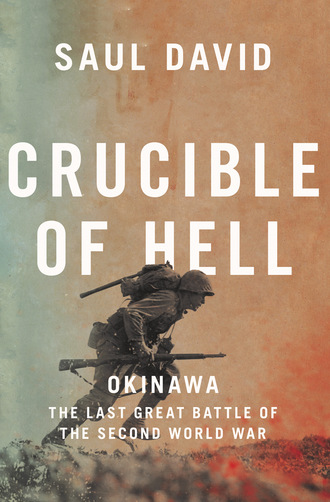
Полная версия
Crucible of Hell

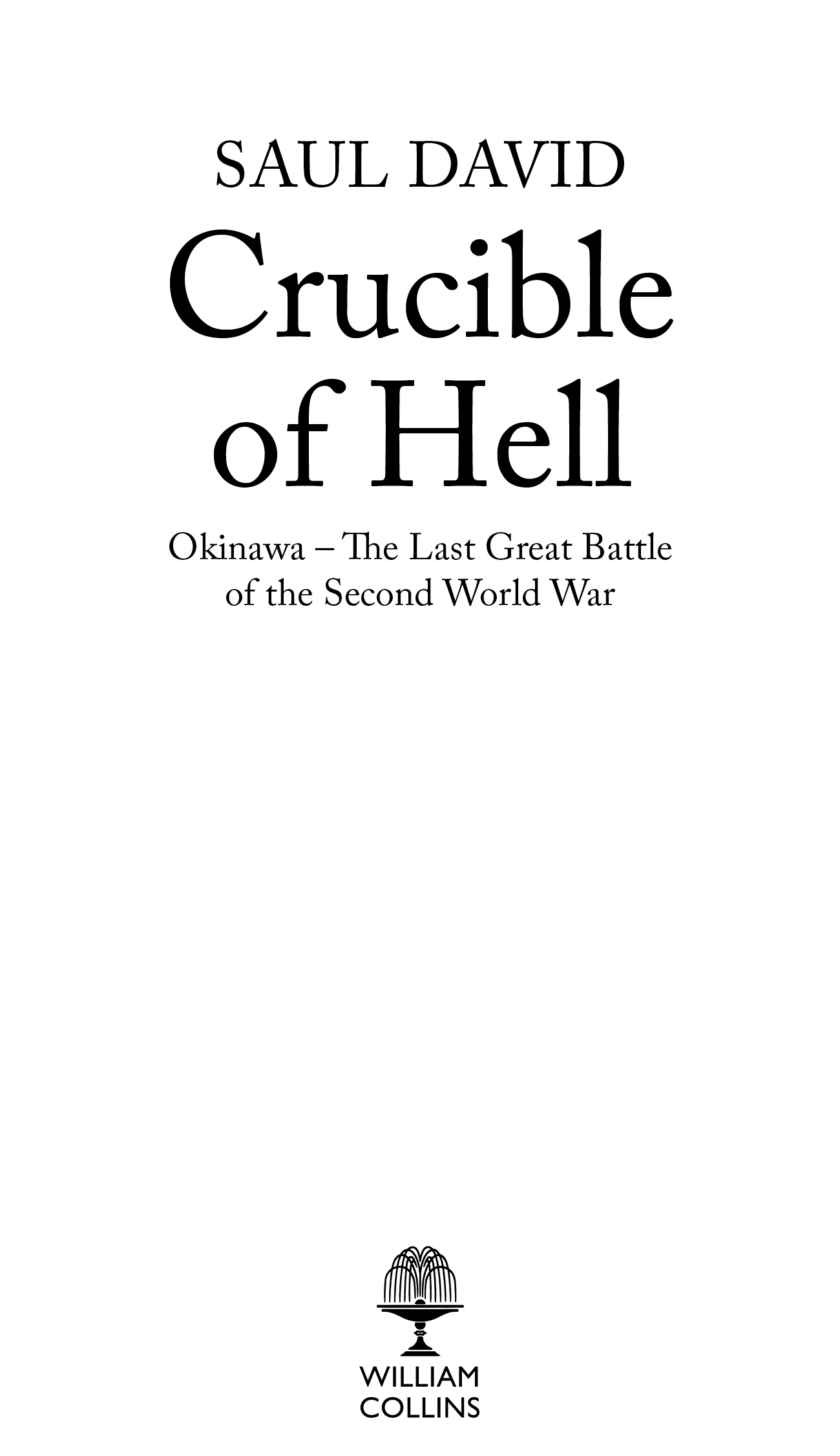
Copyright
William Collins
An imprint of HarperCollinsPublishers
1 London Bridge Street
London SE1 9GF
WilliamCollinsBooks.com
This eBook first published in Great Britain by William Collins in 2020
Copyright © Saul David Ltd 2020
Cover image © Getty Images
Cover design by Richard Lioenes
Saul David asserts the moral right to be identified as the author of this work
Maps by Martin Brown
All rights reserved under International and Pan-American Copyright Conventions. By payment of the required fees, you have been granted the non-exclusive, non-transferable right to access and read the text of this e-book on screen. No part of this text may be reproduced, transmitted, down-loaded, decompiled, reverse engineered, or stored in or introduced into any information storage and retrieval system, in any form or by any means, whether electronic or mechanical, now known or hereinafter invented, without the express written permission of HarperCollins.
Source ISBN: 9780008342487
Ebook Edition © April 2020 ISBN: 9780008342494
Version: 2020-03-02
Dedication
For Matt
Contents
1 Cover
2 Title Page
3 Copyright
4 Dedication
5 Contents
6 List of Illustrations
7 Maps
8 Prologue: Love Day
9 1 ‘Where’s Douglas?’
10 2 Operation Iceberg
11 3 ‘Everybody go home!’
12 4 The Divine Wind
13 5 ‘More concerned with furlough than fighting’
14 6 ‘I’m going simply because I’ve got to – and I hate it’
15 7 ‘I was crying as I did it and she was crying too’
16 8 ‘Tomorrow is our big day’
17 9 ‘It was quite a show’
18 10 ‘There’s always some poor bastard who doesn’t get word’
19 11 ‘The smell of burnt flesh hung about for days’
20 12 ‘War is indeed hell’
21 13 ‘I could see him floating by, face upward’
22 14 ‘Gone? She’s gone?’
23 15 ‘They just knocked the heck out of us’
24 16 ‘I want to marry Shigeko’
25 17 ‘Harry, the president is dead’
26 18 ‘His eyes were rolling in panic’
27 19 ‘Three bullets had ripped into his temple’
28 20 ‘Progress not quite satisfactory’
29 21 ‘All Kaitens prepare for launch!’
30 22 ‘The most terrible weapon’
31 23 ‘Corpsman!’
32 24 Hacksaw Ridge
33 25 ‘We will fight to the last man’
34 26 ‘Doc, this one is worth saving’
35 27 ‘The happy dream is over’
36 28 Sugar Loaf Hill
37 29 ‘Hell’s own cesspool’
38 30 ‘I still hear those cries today’
39 31 ‘The entire enemy line appears to be crumbling’
40 32 ‘It is terrifying to think about’
41 33 ‘There is NO tactical thinking or push’
42 34 ‘I lost damn near all of them’
43 35 ‘You’re just going to have to hang on’
44 36 ‘We were so gullible, so innocent’
45 37 ‘We are down to the final kill’
46 38 ‘I haven’t come up to the front to hide’
47 39 ‘Every man will … fight to the end’
48 40 ‘Suppose it doesn’t go off?’
49 41 ‘What a splendid last moment!’
50 42 ‘All he talked about was you’
51 43 ‘The most terrible thing ever discovered’
52 44 ‘My God, what have we done?’
53 45 ‘We were going to live!’
54 Epilogue: ‘Those dark corners are still there’
55 Picture Section
56 Acknowledgements
57 Notes
58 Bibliography
59 Index
60 Also by Saul David
61 About the Author
62 About the Publisher
LandmarksCoverFrontmatterStart of ContentBackmatter
List of Pagesiiiivvixxxixiiixvxviixixxxixxiiixxvxxvii123456789101112131415161718192021222324252627282930313233343536373839404142434445464748495051525354555657585960616263646566676869707172737475767778798081828384858687888990919293949596979899100101102103104105106107108109110111112113114115116117118119120121122123124125126127128129130131132133134135136137138139140141142143144145146147148149150151152153154155156157158159160161162163164165166167168169170171172173174175176177178179180181182183184185186187188189190191192193194195196197198199200201202203204205206207208209210211212213214215216217218219220221222223224225226227228229230231232233234235236237238239240241242243244245246247248249250251252253254255256257258259260261262263264265266267268269270271272273274275276277278279280281282283284285286287288289290291292293294295296297298299300301302303304305306307308309310311312313314315316317318319320321322323324325326327328329330331332333334335336337338339340341342343344345346347348349350351352353354355356357358359360361362363364365366367368369370371372373374375376377378379380381382383384385386387388389390391392393394395396397398399400401402403404405406407408409410411412413414415416417418ii
Illustrations
PFC Don Dencker, a good student whose hobby was racing pigeons, during training with the 3/382nd Infantry at Camp Luis Obispo, California. (Courtesy of Ann Dencker)
Private Howard Arendt, from Louisville, Kentucky, with five tent mates from the 3/22nd Marines. (United States Marine Corps Archives: USMCA)
A landing ship firing rockets onto Japanese positions on Okinawa in late March 1945. (Library of Congress)
Marines climb into a landing craft on Love Day, 1 April 1945. (USMCA)
Landing craft and ships off Hagushi beaches on Love Day, 1 April 1945. (Department of Defense)
Private Salvatore Giammanco, a 20-year-old Italian immigrant from Brooklyn, the first ground casualty of the campaign. (USMCA)
Major General Lemuel Shepherd, the commander of the 6th Marine Division, with his staff on Okinawa. (USMCA)
An American intelligence officer questions a Japanese prisoner. (USMCA)
The celebrated war correspondent Ernie Pyle enjoys a cigarette break with men from the 1/5th Marines on 8 April 1945, a week after the Okinawa landings. (Department of Defense)
The body of Ernie Pyle, lying in a roadside ditch on Ie Shima. (Department of Defense)
Lieutenant General Mitsuru Ushijima, commanding the Japanese Thirty-Second Army on Okinawa.
Ushijima and staff plot the battle. (Japanese Cabinet Intelligence Bureau)
A Japanese light tank with two of its dead crewmen in the foreground. (USMCA)
Marines follow two M4 Sherman tanks into action. (USMCA)
American troops use a flamethrower to flush out Japanese snipers on a beach. (USMCA)
US Marines assaulting a former Japanese barracks at Shuri in late May 1945. (Department of Defense)
Soldier firing a .30 calibre Browning automatic rifle (BAR) on 2 May 1945. (USMCA)
A rifleman looks for a target, while his officer talks into his battery-operated walkie-talkie. (USMCA)
Standing atop the Maeda escarpment (‘Hacksaw Ridge’), PFC Desmond Doss, a Seventh Day Adventist from Lynchburg, West Virginia. (Department of Defense)
Colonel Francis Fenton kneels beside the body of his son PFC Mike Fenton, a 19-year-old scout/sniper in 1/5th Marines who was killed in the fierce fighting for the Awacha Pocket on 7 May 1945. (Department of Defense)
Ensign Kiyoshi Ogawa, the pilot of one of two kamikaze planes that struck the aircraft carrier USS Bunker Hill on 11 May 1945.
Smoke and flames pour from the USS Bunker Hill after the kamikaze attacks. (Department of Defense)
Sugar Loaf Hill, near Naha. (Department of Defense)
American soldiers collecting supplies dropped by air during the fierce fighting for Shuri Castle in late May 1945. (USMCA)
Japanese schoolgirls wave cherry blossoms to bid a kamikaze pilot farewell as he leaves on his suicide mission from Chiran air base, Kyushu, on 12 April 1945. (Pictorial Press Ltd/Alamy Stock Photo)
US Marines evacuate a wounded colleague. (USMCA)
Two soldiers cover a Japanese sniper hidden in a wrecked church. (USMCA)
Major Bruce Porter DFC, the commander of 542 (N) Squadron. (USMCA)
A US Marine removes grenades from the corpse of a female Japanese soldier killed in the fighting. (Courtesy Himeyuri Peace Museum)
Miyo Takaesu, one of the 118 student nurses of the Himeyuri Corps – recruited from schoolgirls between the ages of 15 and 19 – who perished in the battle for Okinawa. (Courtesy Himeyuri Peace Museum)
Lieutenant General Simon Buckner, with Colonel Clarence ‘Bull’ Wallace and Major Bill Chamberlin of the 8th Marines. (Department of Defense)
Men of the 6th Marine Division raise the Stars and Stripes to signal the end of organised Japanese resistance as they reach the sea at the end of the Kiyan Peninsula on 21 June 1945. (USMCA)
Japanese soldiers surrendering to US forces during mopping-up operations in late June 1945. (Department of Defense)
An aerial view of the ‘Little Boy’ atomic bomb exploding over Hiroshima on 6 August 1945. (Library of Congress)
Maps
World War II in the Pacific
The Battle of Okinawa, 1 April–22 June 1945
The Plan of Attack
The Battle for the Motobu Peninsula, 9–20 April 1945
The Main Battlefield, April–May 1945
Sugar Loaf Hill, 13–15 May 1945
End of Organised Resistance in the Kiyan Peninsula, 18–21 June 1945
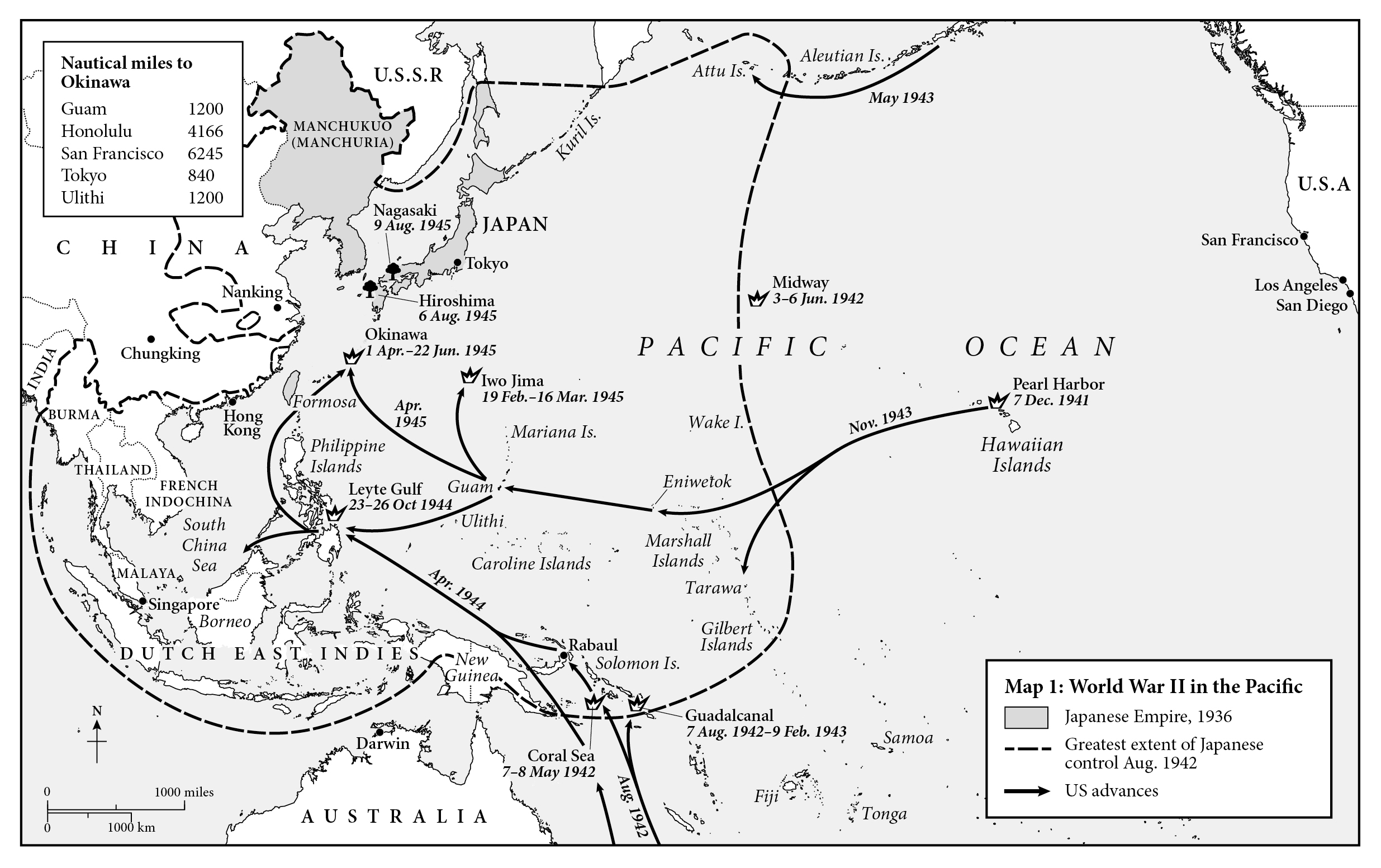



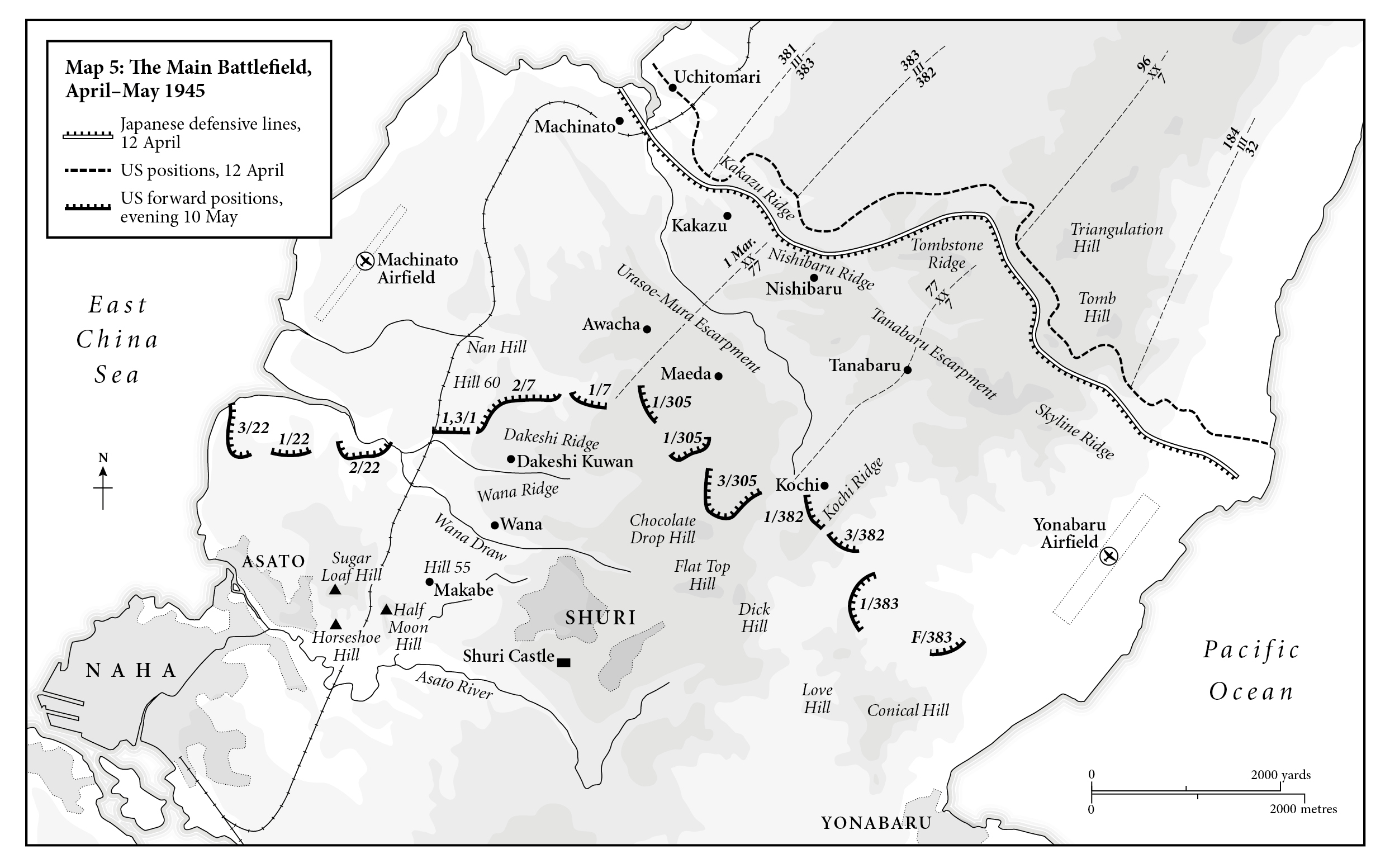
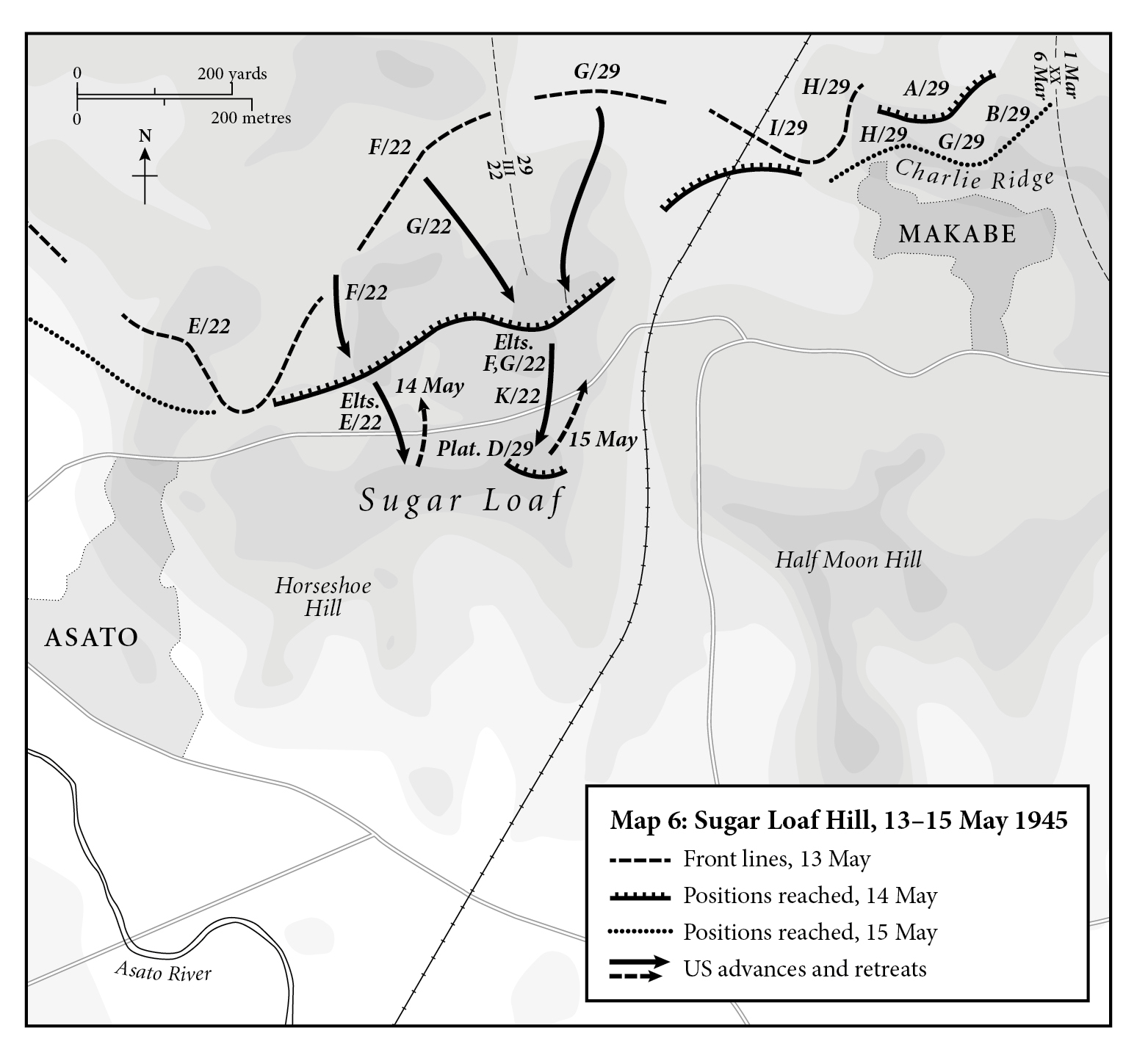
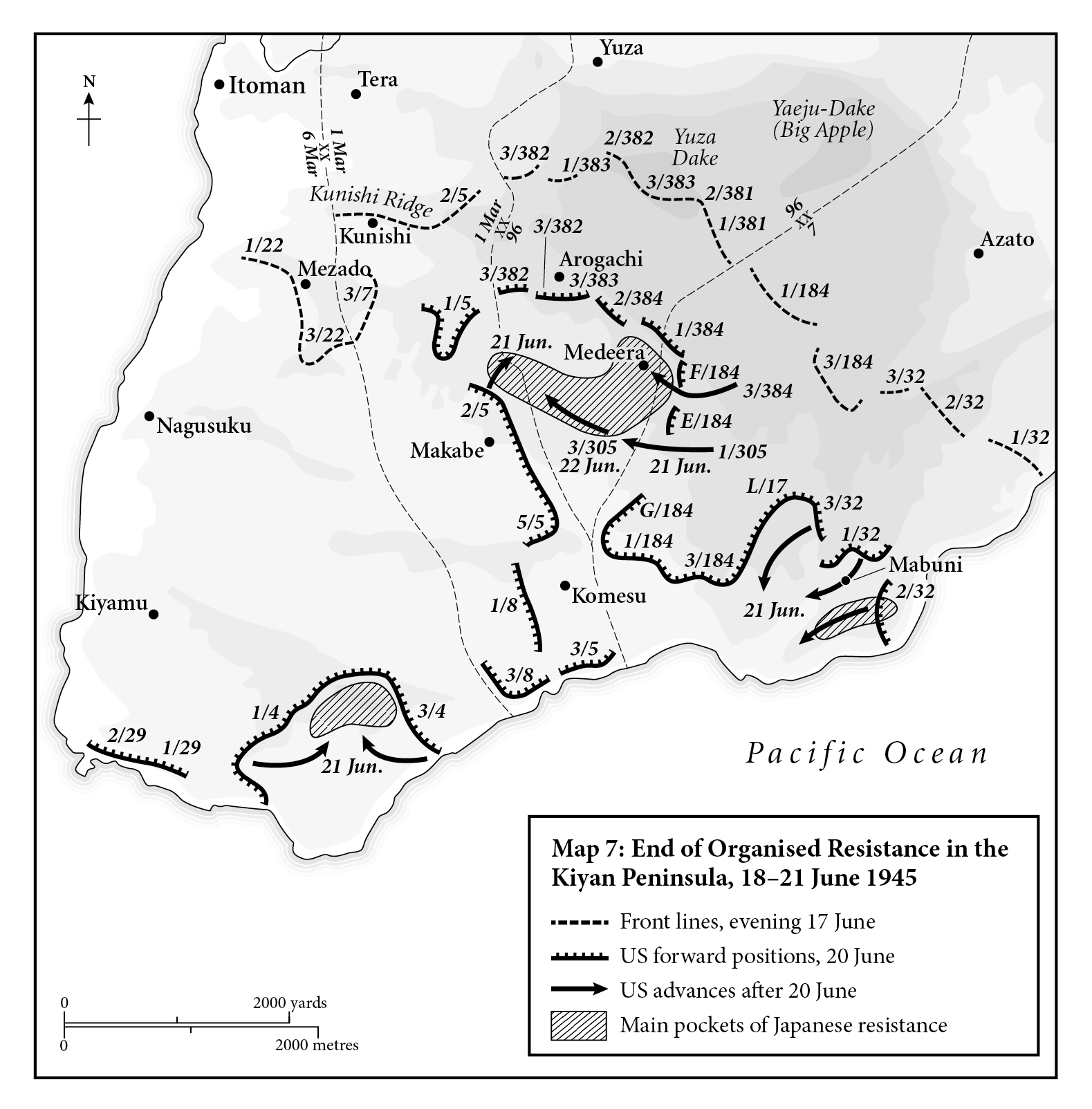
Prologue: Love Day
The USS Eldorado slowed as it approached the west coast of Okinawa in the pre-dawn darkness. ‘Ahead’, noted a US Marine Corps colonel, ‘could be seen the muzzle flashes of naval guns, arcing trajectories of red-hot projectiles, the glow of fires on a distant blur of shoreline. Above the hum of our ship’s circulating blowers could be faintly heard the roll and reverberation of man-made thunder as our supporting battleships, cruisers, destroyers and rocket gunboats increased the tempo of their shore bombardment.’1
Designed as a floating command post, the Eldorado was packed with advanced communications equipment that left space for only two five-inch anti-aircraft guns. Yet she contained a highly valuable human cargo: Vice Admiral Richmond K. (‘Kelly’) Turner, USN, the straight-talking 60-year-old commander of the huge amphibious armada of 1,300 ships and 183,000 combat troops that was converging on Okinawa, the most southerly of Japan’s forty-seven prefectures; and ground-force commander Lieutenant General Simon Bolivar Buckner Jr, 58, the snowy-haired son of the famous Confederate general. It was 1 April 1945, or Love Day,* the code name for the assault, and an auspicious date for Buckner as it was, he noted in his diary, ‘Easter Sunday, my father’s birthday and the day of my first battle.’ He added: ‘I hope I shall be able to look back upon it with the same degree of enthusiasm with which I anticipate it.’2
Eager for the fray, Buckner had risen from his cramped quarters at 4:30 a.m. and, after a quick breakfast of ‘hot cakes’, joined Admiral Turner on the bridge where at 5:30 a.m. precisely they observed through binoculars the opening of the pre-landing bombardment of the target beaches at Hagushi, a third of the way up the seventy-mile-long island, by the fire support force of ten battleships, nine cruisers, twenty-three destroyers, and 177 gunboats. Over the next three hours these vessels fired 44,825 rounds of five-inch or larger shells, 33,000 rockets and 22,500 mortar shells, ‘the heaviest concentration of naval gunfire ever to support a landing of troops’.3
Shortly before 6:00 a.m., as the gunfire continued, the day dawned bright and clear, with excellent visibility of up to ten miles and only a few scattered patches of mist. A moderate breeze rippled the calm sea, and there was no surf on the target beaches. The weather, as anticipated, was perfect for an invasion. ‘The golden sunrise’, wrote a delighted Buckner, ‘was not for Japan.’4
At 7:45 a.m. the bombardment lifted long enough for carrier planes to strafe the beaches with bombs and napalm. ‘Smoke and dust rose up from the shore, thousands of feet high,’ recorded the celebrated war correspondent Ernie Pyle as he watched the spectacle from the command ship of the 5th Marines, ‘until finally the land was completely veiled. Bombs and strafing machine guns and roaring engines mingled with the crash of naval bombardment and seemed to drown out all existence. The ghastly concussion set up vibrations in the air – a sort of flutter – which pained and pounded the ears as though with invisible drumsticks. During all this time the waves of assault craft were forming up behind us.’5
At 8:20 a.m. – ten minutes before H-hour – pennants were hauled down from the control craft and the first wave of amphibious tanks, covering an almost unbroken eight-mile line, began to move towards the shore, a distance of 4,000 yards, at a speed of four knots. They were preceded by gunboats firing enough rockets, mortars and 40 mm guns to saturate each prearranged hundred-yard target square for up to 1,000 yards inland with at least twenty-five rounds. ‘The crescendo of the bombardment’, noted Buckner on the Eldorado, ‘culminating in the rocket discharge was a magnificent spectacle.’6
Following a minute behind the tanks was the first wave of assault troops in amphibian tracked vehicles (or ‘amtracs’), likened by Ernie Pyle to ‘big trucks’ on ‘tractor treads, built cup-like’ that propel them through water and the ‘moment it touches bottom it crawls along like a tractor.’ More followed at ten-minute intervals, with Wave 6 scheduled to leave before Wave 1 hit the beach. Pyle watched them go with a ‘miserable and awful weight’ on his heart. ‘There’s nothing whatever romantic’, he reported, ‘in knowing that an hour from now you might be dead.’7
The advanced elements of four infantry divisions – a total of 12,000 men – were now heading for the shore, fearful of what awaited them. The most experienced was the 1st Marine Division which, in August 1942, had become the first US infantry formation to see action when it invaded Japanese-held Guadalcanal in the Solomon Islands. That bloody campaign had lasted five long months before Japanese resistance was finally broken by the Marines. In 1944 they saw more tough fighting at Cape Gloucester and Peleliu, particularly the latter where the fanatical Japanese defence had cost the division almost 6,500 casualties.8
The ’Canal veterans had since rotated home, replaced by 8,000 raw recruits. But many of the rest remembered the storm of fire that had met them on the beaches of Peleliu and, quite understandably, feared a repeat. Among them was 29-year-old First Lieutenant Bill Looney, a graduate in economics from Chicago’s Roman Catholic Loyola University who had fought and only narrowly survived the last two campaigns as a platoon commander with Charlie Company, 1/5th Marines. Now second in command as the company XO (or executive officer), he and his men had departed their base camp in the Russell Islands a fortnight earlier, aboard a flat-bottomed ‘landing ship, tank’ (LST) that had bunks for 217 men, expecting their target to be the island of Formosa. But after a six-day stop at Ulithi atoll in the Western Caroline Islands – where they were met by the ‘awesome, frightening’ sight of a ‘totally gutted’ and ‘listing’ aircraft carrier, the USS Franklin, which had been bombed by a single Japanese aircraft on 19 March† – they finally learned the truth en route to Okinawa.
Earlier that morning, after a ‘great breakfast’ of steak and eggs, they had watched a battleship shoot down a Japanese kamikaze‡ plane after ‘every other ship in the harbor’ had tried and failed. It was as though the battleship had waited ‘to see if the amateurs could handle it’. The excitement over, Looney and his men were ordered into the amtracs that were crammed into the LST’s hold where the stench of gasoline and the noise of the engines was almost overpowering. Finally the bow doors opened and, one by one, the amtracs splashed into the water as ‘Good luck Marines’ sounded on the ship’s loudspeaker. Looney was half expecting his amtrac to ‘go directly under’, but it stayed afloat and moved slowly towards land.
It was, he remembered, ‘a nervous and quiet group’ crammed into his amtrac, ‘all with the same questions and anxieties going through their minds: are they waiting for us at the shore? How will we get up those sand dunes? Will it be as bad as Peleliu? Will I make it again?’9
Similar thoughts were occurring to Corporal Jim Johnston, a high-school valedictorian who in 1942 had quit the University of Nebraska–Lincoln to join the Marines because he thought it was ‘the honorable thing to do’. Though only 22, Johnston was acting commander of a section of machine-gunners in Easy Company, 2/5th Marines, and felt keenly the weight of responsibility on his shoulders to get his men through the campaign safely. ‘Everyone who had been in front of me in my unit was dead or gone,’ he noted. ‘There was no one to lean on for help. Wherever I looked, someone was looking back at me.’
Their briefing on what to expect had left Johnston extremely pessimistic. Protecting most of the shoreline his company was assaulting was a high sea wall, save for a gap of forty yards with flat land beyond that was covered by machine gun-emplacements. ‘This is our objective,’ he wrote. ‘We must try to secure the flat ground so the tanks and supplies can be landed there. All the defenses the enemy can muster – artillery, mortars, and machine guns – will concentrate their fire on that strategic forty yards. How in the world can a man live through such a place?’ So brutally frank had his officers been that everyone expected Easy Company ‘to be literally destroyed’.10
Up ahead the gunboats turned aside as they reached the shallow coral reef that fringes Okinawa’s western beaches, allowing the amphibious tanks and tracked vehicles to pass through them and proceed unescorted over the reef, the tanks firing their 75 mm howitzers at any pillboxes and strongpoints they could identify. As the tanks neared the shore, the naval bombardment lifted to targets further inland, ‘obscuring the ridges with smoke, blinding the Jap observation posts’, while scores of carrier planes swooped low over the landing beaches to saturate them with machine-gun fire.
The amphibious tanks landed first, followed soon after by the tracked vehicles. As they covered the last few yards to the shore, Johnston remembered the sight of dead Marines in the water and on the beach at Peleliu, and ‘wondered what we would look like to the waves that would come behind us’.11 To Looney, however, the absence of ‘hostile fire’ and ‘no burning amtracs’ was ‘a very good sign’. Carrying long collapsible ladders to scale the steep sand dunes, they piled out of the amtrac and headed for the dunes. ‘Still no action,’ he recorded. ‘It is a walk-on. How great.’12
Johnston approached a pillbox on Yellow 1 Beach, anticipating ‘the impact of bullets ripping into my body’, but there was ‘no fire’. The pillbox was empty. So he and his men moved inland and, within an hour, the beachhead ‘was several hundred yards deep and growing by the minute’. They felt ‘jubilant, absolutely overjoyed’, as if they ‘had been granted a pardon from the death sentence’. But for many it was ‘only a reprieve’.13
Ernie Pyle was still on the 5th Marines’ command ship when word came back by radio that ‘waves 1 and 2 were ashore without much opposition and there were no mines on beaches’. Peering through binoculars, he could see ‘tanks moving across the fields and the men of the second wave walking inland, standing upright’. There was the odd splash in the water near the beach from desultory small-arms and mortar fire, but no sign of ‘any real fire coming from the shore’. It was indicative rather than definitive, yet he felt the weight of dread begin to lift. ‘I found myself talking more easily with the sailors,’ he wrote, ‘and somehow the feeling gradually took hold that we were to be spared.’14
From the deck of the Eldorado it was ‘difficult to see exactly what was happening on the beaches’, noted the Marine colonel, ‘but to our amazement there appeared to be little resistance; our troops reported back that they were crossing the thin strips of coral sand “standing up”. For reasons of their own the Japanese had elected not to defend the beaches.’ He added: ‘Wave after wave of our landing craft hit the beaches, unloaded, and pulled away to their mother ship for subsequent loads. Our troops, Army and Marine, were carried forward by sheer momentum to the high ground of the ventral ridge of the island, where they paused to consolidate and reassess the situation. Behind them the tremendous build-up and congestion on the beaches continued, unhampered by enemy action. It had not been this easy on Peleliu or Iwo Jima.’15
Perhaps the only US serviceman to feel ‘somewhat concerned about the lack of opposition on Okinawa’ that morning was Lieutenant General Buckner. His Marine deputy chief of staff, Brigadier General Oliver P. Smith, put this down to Buckner’s bad experience at Kiska in the Aleutians in August 1943 ‘when Army troops had landed and to their embarrassment … found no Japanese’. Buckner, according to Smith, ‘did not want to be involved in another Kiska’.16
Certainly Buckner was eager to fight, a pugnacity heightened by his lack of combat experience and the fact that in the months leading up to the campaign, he had been fed a steady diet of Japanese horror stories that included photographs of US soldiers who had been ‘butchered and eaten by Japs’.17 Intelligence reports had estimated at least 65,000 Japanese defenders on Okinawa. So where were they? ‘Opposition was light,’ Buckner wrote to his wife that evening, ‘the Japs evidently expected us to land elsewhere in the island … I consider the day highly successful. We have nearly 60,000 troops ashore and will land more tomorrow.’18



